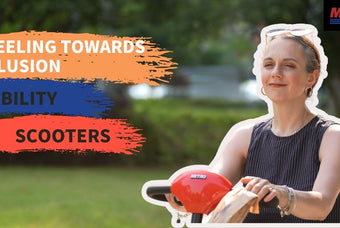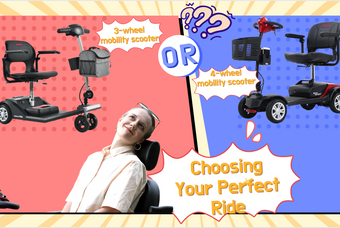
Mobility scooters have become an integral part of many people's lives as they improve their independence and support people with physical or mobility impairments.
As a practical and environmentally friendly means of transportation, it is important to know and comply with the laws that apply to mobility scooters as they become increasingly popular.
Are you considering buying a mobility scooter for yourself or a loved one? Or do you already own a mobility scooter but want to make sure you comply with the laws governing mobility scooter use in the United States?
In this article, we will educate you about mobility scooter laws in 2024, in the United States, to help you navigate a mobility scooter with confidence.
In the United States, the e-scooter is classified as a Power-Driven Mobility Device (PDMD) and falls under the umbrella of the Americans with Disabilities Act (ADA). This ensures that mobility scooters have access to sidewalks and pedestrian areas.
However, it is important to note that state and local regulations on mobility scooter use may vary. Understanding these differences is essential to ensuring the safety of mobility scooter riders and the public.
1. Registration and Licensing
Unlike motor vehicles, mobility scooters generally do not require a license or registration to operate. However, some states may have specific requirements for insurance or identification tags.
A driver's license may also be required in some areas, so it's necessary to research your state's requirements to ensure compliance with the law.
Additionally, laws change constantly and the only way to be 100 percent sure is to pay close attention to relevant news or updates in your area.
Every state may have local councils in some cities that prohibit or restrict the use of electric scooters in certain areas. Of course, there may also be differences between rented and privately owned scooters.
2. Speed Limits
There is no uniform speed limit for electric mobility scooters in the United States. Most electric scooters typically travel at speeds of 4 to 8 miles per hour to ensure the safety of riders and pedestrians.
Here are some helpful resources:
- Your state's Department of Motor Vehicles (DMV) website. This is the best way to find specific laws and regulations regarding mobility scooter speed limits in your area.
- The National Conference of State Legislatures (NCSL) website. Their website may provide a general overview, but be sure to double-check with your state's DMV.
- Disability rights organizations in your area. They are a valuable resource for information on mobility scooter laws and safety.
3. Road Usage
Mobility scooters are usually not allowed on highway roads. If they are allowed on roads, they are usually limited to roads with a speed limit of 25 mph or less. In this case, the specific speed limit for scooters may be the same as the posted speed limit on the road.
While mobility scooters provide freedom of movement, their use may be restricted or prohibited in certain areas. These areas may include airports, train stations, and certain public buildings. Be sure to familiarize yourself with any signs indicating restrictions on the use of mobility scooters.
4. Federal Air Travel Regulations
If you plan to travel by air with a mobility scooter, it is important to understand the regulations set forth by the Federal Aviation Administration (FAA).
Airlines are required to make accommodations for passengers with mobility scooters, but advance notice may be required. In addition, scooter batteries must meet specific guidelines to ensure safe air travel.
5. Here are some of the regulations for popular areas that our customers frequently inquire about
- California
In California, electric scooters are a popular mode of transportation, especially in urban areas. Riders must have a valid driver's license or learner's permit and must wear a helmet if they are under 18.
Scooters cannot be ridden on sidewalks and must be operated in bike lanes or on roads with a speed limit of 25 mph or less. Electric scooters have a maximum speed of 15 mph.
- Washington
In Washington, electric scooters can be ridden on roads, bike lanes, and sidewalks. The maximum speed limit is 15 mph.
Proper safety precautions should be taken when riding a mobility scooter. This may include wearing a helmet, using lights and reflectors at night, and keeping the scooter in proper working order.
- New York
New York legalized e-scooters in August 2020, considering that e-scooters help the city and can ease traffic congestion. Riders must be at least 16 years old, and those under 18 must wear helmets.
The maximum speed limit for scooters is 20 mph.
It is illegal to ride an e-scooter on a sidewalk or street above the 30 mph speed limit.
- Florida
Florida allows electric scooters on streets and bike lanes but prohibits their use on sidewalks. Riders must follow the same rules as bicyclists, including obeying traffic signals and signs.
Riders under the age of 16 must wear a helmet, and registration is not required if the vehicle's maximum speed is less than 20 mph.
The max speed is 30 mph.
More detailed rules for the area can be found here.
6. Some tips for electric scooter users
- Always obey speed limits and traffic signals.
- Use sidewalks and designated paths whenever possible.
- Pay attention to your surroundings and keep a safe distance from pedestrians and obstacles.
- Choose an electric scooter equipped with headlights and taillights to cope with low light conditions.
- Always wear a helmet (although not necessarily mandatory, it is highly recommended). Especially at high speeds or on uneven roads.
- Never carry more weight than the mobility scooter can carry.
- Always use the LED turn signals when turning or changing lanes.
Conclusion
While electric mobility scooters provide convenience for us, especially those with mobility issues, it is important for anyone using an electric scooter to be up-to-date on the laws and regulations governing the use of electric scooters in the area.
Navigating U.S. mobility scooter laws is not complicated. By familiarizing yourself with the regulations outlined in this guide and researching the specific laws in your state or territory, you can enjoy the freedom and independence that comes with a mobility scooter.
Remember that safety always comes first and operate your mobility scooter responsibly at all times.




![The Ultimate Guide to U.S. Mobility Scooter Laws [2024]: Navigating the Roads Safely](http://www.metromobility.com/cdn/shop/articles/659dbd131984e32a9218fd22d4d496f8_340x228_crop_center.jpg?v=1713341418)

0 comments. Write a comment